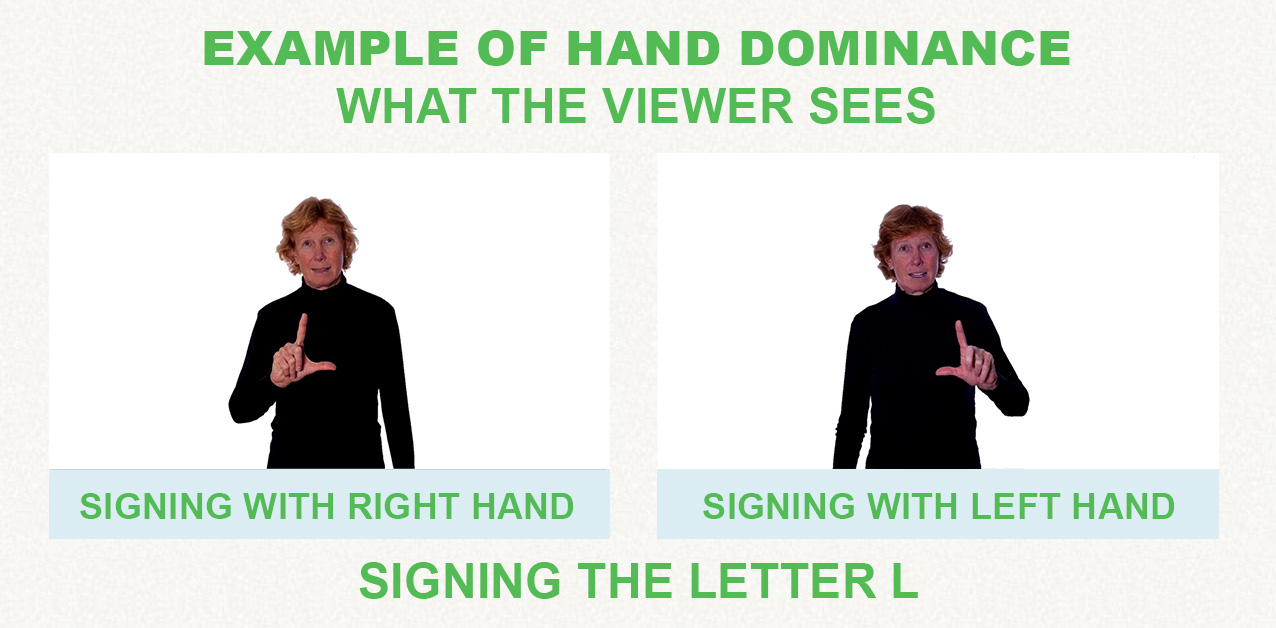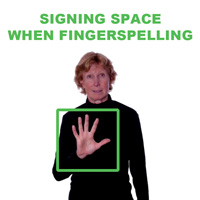Does it matter which hand I sign with? Using Your Dominant Hand When Signing
In American Sign Language some signs use one hand and others use two hands. Fingerspelling uses only one hand. This leads to several questions about WHICH hand you should sign with and when. The following should help answer your questions.
What hand should I use when fingerspelling and when a sign only uses one hand?
Use your dominant hand when fingerspelling and forming signs that use one hand.
It is pretty straightforward, but if you still have questions, we have the answers...
Which hand is my dominant hand?
We commonly use the terms “right-handed” and “left-handed” to describe hand dominance. If you are right-handed, your right hand is your dominant hand. If you are left-handed, your left hand is your dominant hand.
Your dominant hand is the hand you tend to favor or use the most for activities that require one hand, such as writing. Think about which hand you use to write, brush your teeth, or open a jar.
If I am ambidextrous or left-handed, but feel comfortable using my right or left hand to sign, should I try to use my right hand?
If you are ambidextrous (able to use your right and left hands equally), or if you are left-handed but feel comfortable doing some activities with your right hand, and you are wondering if you should try to use your right hand as your dominant hand when signing, here are some things to think about:
- Are you just starting to sign or have you been signing for quite some time? If you are just beginning to sign, then you may have more flexibility to choose which hand you want to use as your dominant hand when signing. If you have been signing for some time, it may be difficult to change your dominant hand.
- It is really about what feels most comfortable and natural to you when signing. It is a question only you can really answer. You need to pick one dominant hand.
- If you feel strongly that you could equally use either hand for your dominant hand when signing, there are some advantages to using your right hand. However, these reasons should not persuade you to use your right hand if you are more comfortable with your left hand because the most important thing is that you are consistent with which hand you use as your dominant hand.
- Since 90% of people are right-handed (Price, 2009), you will see the majority of people signing with their right hand as their dominant hand. Therefore, you will see more sign models with right-hand dominance. Your signing may also look more like others if you sign with your right hand.
- Based on research, signers are faster to process phonologically simple signs produced by right-handed signers and faster to process complex signs with asymmetrical handshapes by same-handed signers (Watkins & Thompson, 2017).
- Since 90% of people are right-handed (Price, 2009), you will see the majority of people signing with their right hand as their dominant hand. Therefore, you will see more sign models with right-hand dominance. Your signing may also look more like others if you sign with your right hand.

What is the most important thing about choosing a dominant hand?
Whether you are right-handed or left-handed or ambidextrous, it is strongly suggested you pick a dominant hand and stick with it.
Which hand is my non-dominant hand?
Your non-dominant hand is the hand you do not use as your dominant hand.
Does it matter which hand is my dominant hand versus non-dominant hand when forming signs that use two hands?
Yes. You should pick a dominant hand and consistently use it as your dominant hand.
When signing with two hands, signs typically have the dominant hand do the primary action in the sign (although that is not always the case, some signs have the hands doing the same motion, some vary while signing, or less frequently some have the non-dominant hand do the motion).
Each sign in Signing Savvy has a sign description and you will see it describes how to form the sign by explaining where and what the dominant and non-dominant hands are doing.
Examples of Signs That Use One Hand – Using The Dominant Hand
These are all examples of signs that use only one hand, the dominant hand, when being formed. Almost all signs formed with one hand use the dominant hand.
 |
||
Examples of Signs That Use One Hand – Using The Non-Dominant Hand
It is rare for the non-dominant hand to be used when forming signs that use only one hand. The following signs ALWAYS use the same hand EVEN if it is the non-dominant hand due to the meaning of the word. That is, you always use your right hand for RIGHT and your left hand for LEFT even if one or the other is your non-dominant hand.
 |
Examples of Signs That Use Two Hands – Dominant Hand Does Primary Motion
Most signs that use two hands with one hand doing the primary motion, use the dominant hand when forming the motion. These are all examples of signs that use both hands and the dominant hand does the primary motion when forming the sign.
 |
||
Examples of Signs That Use Two Hands – Non-Dominant Hand Does Primary Motion
It is less common for a two-handed sign to have the non-dominant hand form the primary motion in the sign. One example is the sign MEET (as in, “meet me”). The non-dominant hand moves towards your body and dominant hand. In this sign your two hands in the 1 handshape represent people – the dominant hand represents you and the non-dominant hand represents another person. The non-dominant hand (the other person) moves towards the dominant hand (you) to sign someone meeting you.
 |
Example of Signs That Use Two Hands – Hands Form the Same Motion
These are all examples of signs that use both hands and hand dominance is not emphasized when forming the sign.
 |
||
Example of the Importance of Hand Dominance and How Small Changes in Position and Movement Change the Meaning
The example of signing MEET (as in, “meet me”) was shown above, however, there are different ways to sign MEET, each with different meanings. These three examples all show how to sign MEET. These examples show how small changes in position and movement change the meaning of what is being signed. So, it is important to pay attention and be aware of hand dominance.
 |
||
- MEET (as in "I met"): The dominant hand moves away from your body and towards the non-dominant hand. In this sign your two hands in the 1 handshape represent people – the dominant hand represents you and the non-dominant hand represents another person. The dominant hand (you) moves towards the non-dominant hand (the other person) to sign you meeting someone.
- MEET (as in "meet me"): The non-dominant hand moves towards your body and dominant hand. In this sign your two hands in the 1 handshape represent people – the dominant hand represents you and the non-dominant hand represents another person. The non-dominant hand (the other person) moves towards the dominant hand (you) to sign someone meeting you.
- MEET (as in "they met"): Both hands begin at each side of the torso and move towards each other ending in front of the chest. In this sign your two hands in the 1 handshape represent people. They come together to sign two people meeting.
- MEET (as in, "to meet many people"): The dominant and non-dominant hands face each other and both continuously pass each other as the hands move from the non-dominant to dominant side of the body. In this sign your two hands in the 1 handshape represent people. Think of meeting many people as you wander through a party.
May I switch which hand is dominant and non-dominant while signing?
If you use your non-dominant hand instead of your dominant hand, or if you switch hand dominance while signing, deaf people will likely still understand you, but it can be a distraction and your signing may not look as smooth. You may think of it as a non-native English speaker speaking English haltingly or with a heavy accent. To maintain clarity, it is highly recommended you pick one dominant hand and consistently use it as your dominant hand.
Never start fingerspelling with one hand and then switch to the other hand.
Still have questions on hand dominance?
For more information on hand dominance and signing, see “The relationship between sign production and sign comprehension: What handedness reveals” by Freya Watkins and Robin Thompson.
Resources
- Price, M. (2009, January). The left brain knows what the right hand is doing: New research explores how brain lateralization influences our lives. American Psychological Association, 40(1), 60. https://www.apa.org/monitor/2009/01/brain
- Watkins, F., & Thompson, R. L. (2017, July). The relationship beween sign production and sign comprehension: What handedness reveals. Cognition, 164, 144-149. https://doi.org/10.1016/j.cognition.2017.03.019
ADVERTISEMENTS
 Brenda Cartwright is a Coda, seasoned interpreter, a master teacher, well known presenter, and author of several best selling sign language and interpreting textbooks from the RID Press. For 35 years Brenda was the Chair of the Sign Language Interpreter Program at Lansing Community College in Lansing, Michigan.
Brenda Cartwright is a Coda, seasoned interpreter, a master teacher, well known presenter, and author of several best selling sign language and interpreting textbooks from the RID Press. For 35 years Brenda was the Chair of the Sign Language Interpreter Program at Lansing Community College in Lansing, Michigan. Signing Space When Fingerspelling
Signing Space When Fingerspelling Common Fingerspelling Mistakes New Signers Make
Common Fingerspelling Mistakes New Signers Make Tips When Starting to Fingerspell
Tips When Starting to Fingerspell







